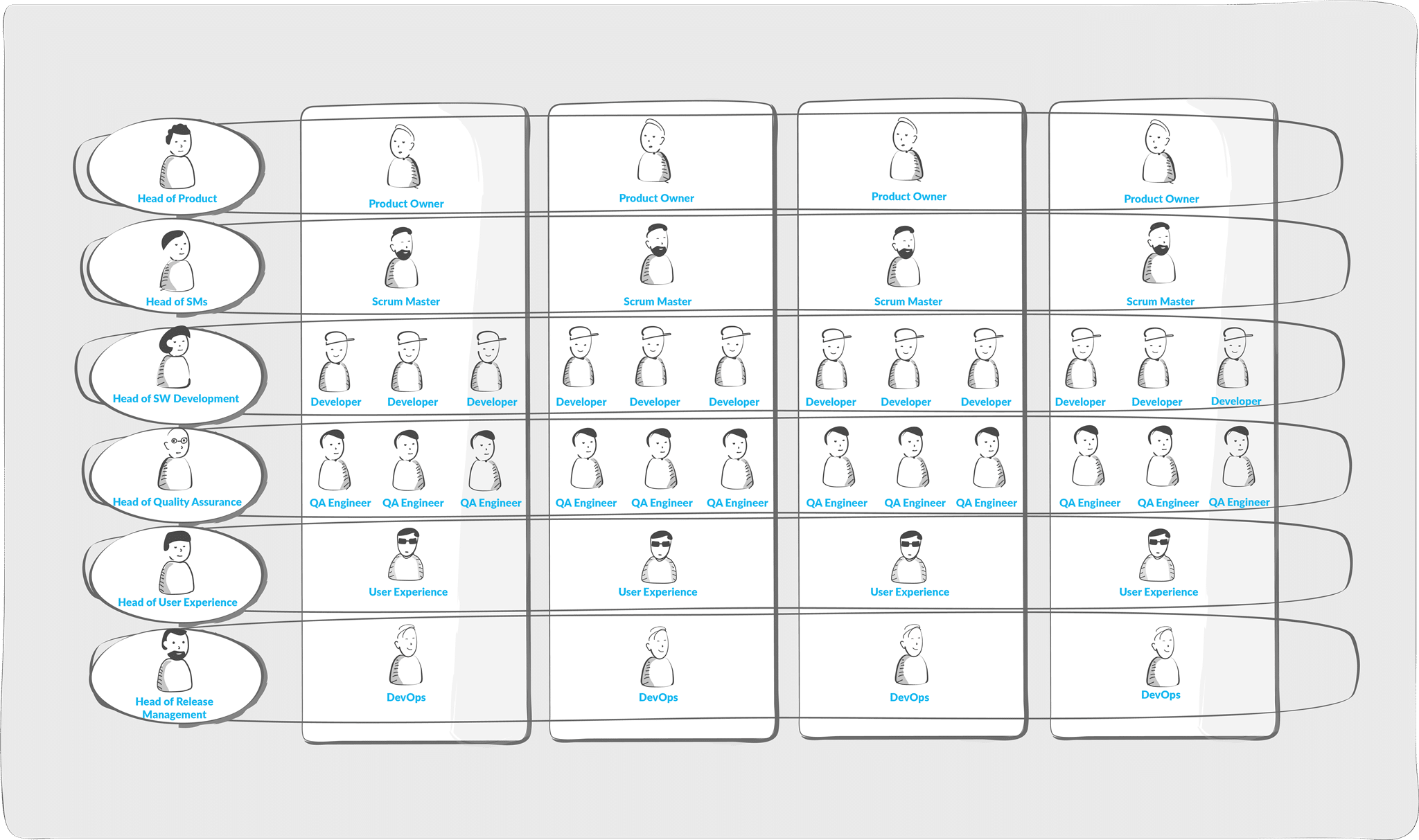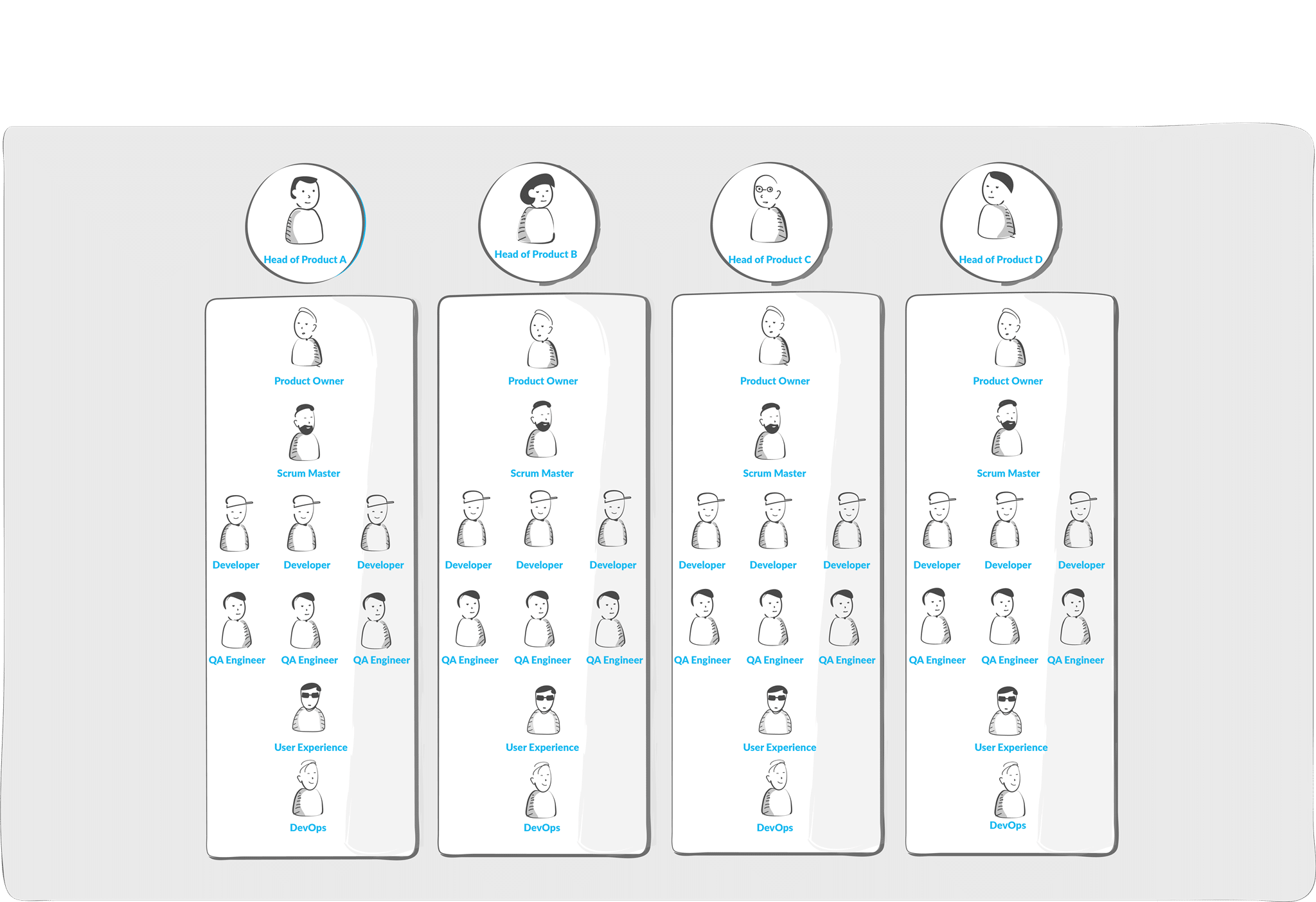Share this
Product Organization Structure For Every Digital Company
by Luis Gonçalves on Jan 13, 2024 5:50:37 AM

The success of a company largely depends on how well it organizes its resources, especially in today's fast-paced and competitive business environment. One critical aspect of resource organization is the product organization structure.
This article will dive into the concept, types, advantages, disadvantages, and factors to consider when choosing a product organization structure. We will also discuss the role of key players in the structure and end with a case study and FAQs.
Society changed and leaders need support in the way how they lead and design their digital product organizations, that is the reason why the ADAPT Methodology® was created, but now let’s get a deep dive into the “Product Organization Structure” topic.
What is a Product Organization Structure?
A product organization structure is a framework that defines how a company's resources and personnel are allocated to design, develop, and manage products. This structure promotes efficient decision-making, collaboration, and innovation by aligning employees' skills and expertise with the organization's goals and product strategy.
Types of Organization Structures
Functional Organization
In a functional organization, employees are grouped by their specific skills and expertise. Departments are created based on the functions they perform, such as marketing, engineering, and design. This structure is best suited for companies with a single product line or a few similar products.
Divisional Organization
Divisional organizations group employees based on product lines or market segments. Each division functions as a semi-autonomous unit with its resources and personnel responsible for the entire product life cycle. This structure is ideal for larger companies with multiple product lines or diverse markets.
Matrix Organization
The matrix organization combines elements of both functional and divisional structures. Employees report to both a functional manager and a product manager, fostering collaboration and communication across departments. This structure is best suited for organizations that need to balance functional expertise with product-focused decision-making.
Cross-functional Teams
Cross-functional teams bring together employees from different departments to work on specific projects or products. These teams enable better collaboration and communication, helping organizations to innovate and adapt more quickly. This approach is ideal for companies with rapidly changing markets or a strong focus on innovation.
Advantages of a Product Organization Structure
- Improved collaboration and communication across departments.
- Streamlined decision-making and faster time to market.
- Increased focus on customer needs and market trends.
- Enhanced innovation and adaptability.
- Better alignment of resources and expertise with product strategy.
Disadvantages of a Product Organization Structure
- Potential for increased complexity and confusion, especially in matrix organizations.
- Higher resource requirements for creating and maintaining separate divisions or teams.
- Possible duplication of efforts and inefficiencies.
- Resistance to change from employees used to traditional structures.
Factors to Consider When Choosing an Organization Structure
- Company size and a number of product lines.
- Nature of the market and industry.
- A degree of innovation and adaptability is required.
- Existing company culture and willingness to change.
- Resource availability and allocation.
Transitioning to a Product Organization Structure
Transitioning to a product organization structure can be challenging but rewarding. Here are some steps to facilitate the process:
- Assess the current organization structure and identify areas for improvement.
- Define clear goals and objectives for the new structure.
- Involve key stakeholders in the decision-making process.
- Develop a detailed plan for the transition, including timelines and milestones.
- Communicate the changes and provide training and support for employees.
- Monitor progress and make adjustments as needed.
Best Practices for Implementing an Organization Structure
- Define clear roles and responsibilities for all team members.
- Foster open communication and collaboration across teams and departments.
- Establish performance metrics and regularly review progress.
- Encourage innovation and adaptability.
- Provide ongoing training and development opportunities for employees.
Role of the Product Manager in a Product Organization Structure
In a product organization structure, the product manager plays a critical role in defining product strategy, overseeing development, and ensuring alignment with customer needs and market trends. They also coordinate cross-functional teams, manage resources, and measure product performance.
Role of the Product Owner in a Product Organization Structure
The product owner is responsible for defining and prioritizing product requirements and working closely with the development team to ensure that the product meets customer needs. They also act as a liaison between the product manager, stakeholders, and the development team, ensuring clear communication and collaboration.
Role of the Development Team in a Product Organization Structure
The development team is responsible for designing, building, and testing the product according to the requirements defined by the product owner. They collaborate closely with the product owner and other team members to ensure that the product meets customer needs and aligns with the overall product strategy.
Collaboration and Communication in a Product Organization Structure
Effective collaboration and communication are essential in a product organization structure. This can be achieved through regular meetings, open channels of communication, and the use of collaboration tools such as project management software and instant messaging platforms.
Measuring Success in a Product Organization Structure
Success in a product organization structure can be measured through various metrics, including:
- Time to market.
- Customer satisfaction and feedback.
- Product performance and revenue growth.
- Employee engagement and satisfaction.
- Innovation and adaptability.
Moving From A Project to a Product Organization
Most project organisations apply a matrix model, this structure is a completely outdated model for companies that are creating Digital Products, but if your business model is to build projects this organizational design might not be that bad. On the contrary, if you are building Digital Products you want to take a look into a different way to design your company, so let’s dig into this topic.
An organizational structure with a matrix design is bad
Spotify’s document about tribes and guilds became extremely popular in the Agile community. If you take a look into their organizational structure, you will see they are using a matrix organizational structure and in my opinion, this is not the best approach. Before I continue, I would like to explain what an organization structure based on a matrix organizational structure is, just to make sure that you fully understand what I want to say.
In simple terms, a matrix organization is an organization where vertical projects are staffed with several individuals from different parts of the company belonging to several different departments. This approach is extremely common because most companies are built like this.
Below you can find a picture that represents an organizational structure based on the matrix method:

Over the years, I have worked with many companies where this organizational structure is present; based on my experience, I will outline the following problems common to it.
Extremely Political Environment
It is not uncommon for organizations with this kind of setup to suffer from political issues. The team in this situation is a bunch of individuals from different parts of the organization who are brought together to deliver something.
My experience tells me the problem is not with team members but with line managers. If everything is going well, line managers tend to say that success is a result of their team members.
If something really bad happens, line managers tend to say the problems are due to the other departments. They enter into “save my ass” mode, trying to cover their ass instead of helping the organization to find the problem.
Blame Culture
I believe this is partly the result of the previous problem. When something goes wrong, people from different departments try to save their asses and blame everyone other than themselves. Unfortunately, I see this happen too often.
Horizontal Line interference
Over the span of my career, I’ve seen this happen in almost every company where I worked: Moving towards Agile is something difficult for most middle managers.
There are clear roles for Product Owners, Scrum Masters, and Team Members, but nothing for Agile Managers.
Managers try to do their best to help people, but in my humble opinion, most of the time their actions in these situations cause more harm than good. They try to give “one-on-one” help to people regarding career development, they try to establish team events, and they try to do many other things, but in reality, all these activities remove people’s focus from their product team.
Another typical example is the practice of having all these line managers in all kinds of meetings, for example, dailies, planning, reviews, etc. Because they want to see what their guys are doing, they go to these meetings, but unfortunately, most of them cannot keep quiet, and therefore they end up sabotaging the discussion and making all these meetings quite inefficient.
Decisions take a lot of time to be made
Of course, in theory, the team should own all their decisions, but with so many “chefs in the kitchen”, I can guarantee that any decision that ought to take just a few minutes will take weeks of negotiation with this kind of organization structure—Not productive at all.
Individual Goals mess
People who follow my work know how I hate personal goals attached to individual performance. In this organizational structure, I believe we have the right setup to launch the company into chaos and drain people´s motivation.
Let me explain: Having several horizontal line managers implies (in most organizations) that each different person will have a different goal or goal defined by his/her manager.
Now, if you imagine that in a team of 7, everyone has two goals, for example, this means that we have a total of 14 individual goals that have nothing to do with the team goal, which is the most important one.
Of course, you can say the team as a whole will have its goal, and all the individual goals will end up aligned with the team goal, but do you believe that with so many different managers, different people, and different goals, people will be aligned with the team goals? Well, hardly, at least I do not believe.
Interference with new hiring
Several years ago I had the opportunity to be part of a sad story. At that time I was Scrum Master, and the team was recruiting a developer; of course, we all looked for senior developers. We had several interviews with several candidates, but only one guy seemed to be a perfect fit for our team. We all agreed he was our man. We communicated with everyone and said he should be hired.
A couple of days later, the head of software development informed us that HE had chosen another guy. So basically, a guy who was not part of our team, who would not work daily with the new developer, who did not have any idea about what we needed, decided the future of the whole team. Later on, we found out that he was simply trying to achieve his personal yearly goal (saving money for the department).
Our companies are full of such cases, demonstrating how the horizontal line manages without understanding their place in Agile Organisations, and how this can harm the company a great deal.
A Product Value Stream Approach
So what can be done? How can we assemble cross-functional teams that have everything needed to allow high performance?
Before I describe my approach, I want to warn you; that this is quite a radical approach to traditional management.
I know this cannot be implemented in most companies (or at least, those typical managers), but I truly believe in Peter Senge’s words:
“It´s not enough to change the structures if the mindset behind does not change“
I think this is one of most companies’ biggest problems: they keep trying to solve old problems with old ways of working. If you truly want to make a difference, you truly must change the way you think—to that end; I choose to present something more radical than the norm.
We want to create teams that:
- Are small, directly communicating with each other
- Where everyone takes responsibility for their work
- Make decisions fast
- Celebrate small successes
- Are not political
- Have end-to-end responsibility
- Are focused on real, important things
- Can release their products several times a day if necessary
- Budget independent
- Have all the necessary people to make the product live
If you think about all these characteristics, this is exactly what a Startup is. So, why not create small Startups within our companies, meaning Product Value Streams?
Before you say this idea is ridiculous, consider the fact that there are several companies all over the world already testing this concept.
So, how can we assemble this kind of setup? To achieve this kind of setup we should create cross-functional teams that are fully independent.
Everyone reports to the same person (the Startup CEO), and this small team has all the necessary people and necessary skills to make the product live.
Below you can find a picture illustrating this setup.

Pros and Cons of this approach
Since I presented the positive aspects above, I will now focus on the negative points of this approach:
There is no space for middle management – If companies chose to implement this approach, middle managers would not have a role. Of course, they can do any other job that is necessary to release the product, but typically this will not be a manager role—it will be a specialist role, which means that middle managers must adapt to new jobs.
Communication with other Start-Ups – The ideal setup will be able to create fully independent products without requiring much communication with the rest of the organization, but we still want to share best practices with the rest of the company. Here people must be careful not to get isolated from the other parts of the organization. Typically a well-established Community of Practices will tackle this problem.
A lot of courage is needed – To implement this kind of approach, top management must have a lot of courage. This is a completely radical approach, and it requires a lot of courage to try something so new like this. Even if management can implement this, the company must have a great culture of learning from its mistakes, as this will be the only way to achieve success using this approach.
I believe if we have the courage and the vision to start building companies in this way, we will be able to create products faster and more successfully than ever.
Conclusion
A product organization structure can significantly impact a company's success by fostering collaboration, innovation, and efficient decision-making.
When choosing the appropriate structure, it's essential to consider factors such as company size, market, and industry.
By implementing best practices and clearly defining roles and responsibilities, companies can benefit from a well-organized product structure that aligns with their goals and objectives.
In a project-based organization, the project team is usually assembled for the duration of the project and then disbanded once the project is completed. The team may include a project manager, subject matter experts, and a variety of other specialists, such as designers, engineers, or developers.
In contrast, a product-based organization is focused on creating and selling a product or set of products to customers. This type of organization is often structured around product value streams that contain all the skillsets required to develop the product, such as marketing, sales, engineering, and customer support.
The movement from project to product is becoming bigger, therefore, we truly believe that we would need to write a small article on this topic: project to a product organization, we hope you enjoyed it.
Did you like this article?
We enable leaders to become highly valued and recognized to make an impact on the World by helping them to design Digital Product Companies that will thrive and nourish in the Digital Age, we do this by applying our own ADAPT Methodology®.
Share this
- Agile Methodologies (18)
- Product Strategy (18)
- OKRs (16)
- Scrum (16)
- Product Mindset (14)
- Project To Product (10)
- Agile Retrospectives (9)
- CoPs (9)
- Knowledge Sharing (9)
- Time To Market (8)
- Product Discovery (7)
- Continuous Improvement (5)
- Strategy (5)
- Scrum Master (4)
- Content Marketing Strategy (3)
- Product Owner (3)
- Technical Excellency (3)
- Digital Transformation (2)
- Innovation (2)
- Scaling (2)
- Team Building (2)
- Business Model (1)
- Cost Of Delay (1)
- Customer Feedback (1)
- Customer Journey (1)
- Customer Personas (1)
- Design Thinking (1)
- Digital Leadership (1)
- Digital Product Tools (1)
- Go To Market Strategy (1)
- Google Design Sprint (1)
- Lean Budgeting (1)
- Lean Change Management (1)
- Market Solution Fit (1)
- Organisational Impediments (1)
- Outsourcing (1)
- Product (1)
- Product Metrics (1)
- Product Roadmaps (1)

Organisational Mastery
Get your free copy

ADAPT
Get your free copy

Product First
Get your free copy


